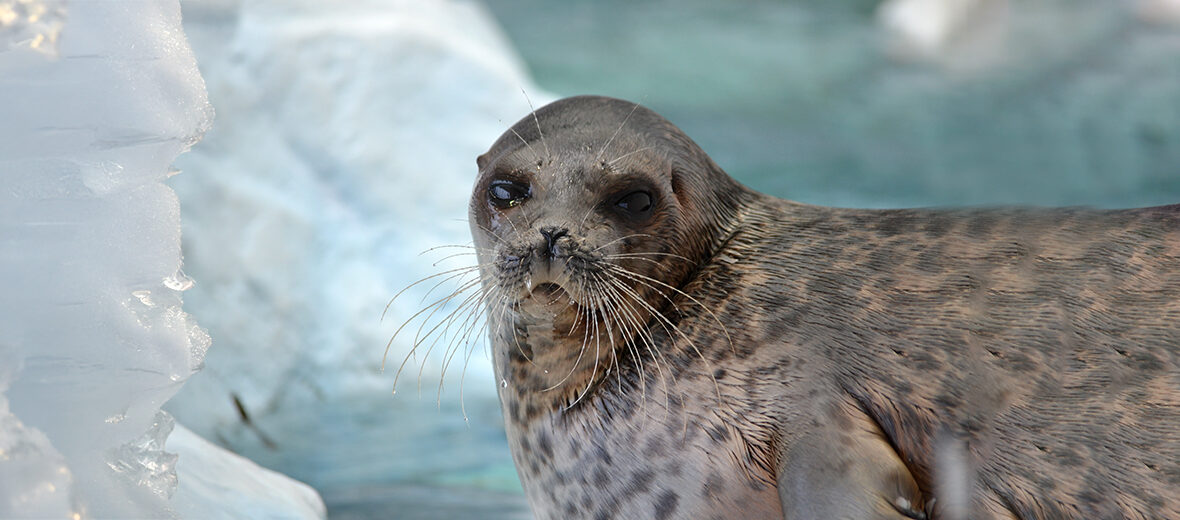
The ringed seal is a small earless seal species found throughout the Arctic and sub-Arctic regions on every continent in the northern hemisphere. In fact, they are the most abundantly found seal in the northern hemisphere. Due to their large population of an estimated 1,500,000 individuals, these seals face many threats. They face the threats of vehicle strike, being hit by ships and boats in shipping lanes; overfishing; recreational activities, that interrupt their breeding grounds; pollution, both water and land; and climate change, that can cause warmer weather and also interfere with their food source. However, they remain numerous and are thus listed as Least Concern by the IUCN.
First the Stats…
Scientific name: Pusa hispida
Weight: Up to 309 lbs.
Length: Up to 5 feet
Lifespan: Up to 43 years
Now on to the Facts!
1.) Ringed seals are the smallest seal species in the northern hemisphere.
2.) Polar bears, orcas, Arctic foxes, gulls, Greenland sharks, and indigenous people prey on these seals.
3.) Among all their threats, the biggest by far is climate change. The warming of sea and air temperatures cause drastic ice melt and interupt the life cycles of their prey items. However, climate change may very well decimate their predators first allowing these seals to ultimately thrive afterall.
4.) Of the 10 suggested subspecies, currently 5 distinct subspecies are recognized: P. h. hispida, P. h. ochotensis, P. h. saimensis, P. h. ladogensis, and P. h. botnica.
5.) These seals have an affinity for pack ice, more so than many other seals.
But wait, there’s more on the ringed seal!
6.) Ringed seals are solitary and typically separate themselves by several hundred yards. They only come together for a few days to mate. Then the male leaves in search of a new mate.
7.) Females undergo up to an 11 month gestation (pregnancy) that yields a single pup.
Did you know…?
In 2012 the Government of Nunavut warned pregnant women to try and avoid eating ringed seal liver due to elevated levels of mercury, however they also stated that eating traditional “country food” is still ok for adults to consume.
8.) Pups are weaned in up to 2 months and quickly develop a thick layer of blubber to shield themselves from the cold.
9.) Arctic cod, herring, and shrimp are among the 72 known species of aquatic life these seals prey on.
10.) In the past 2,000 years, summer temperature highs have never been worse, based on paleo-climate reconstructions. This warming is due to climate feedback mechanisms based upon sea-ice melt. As the sea ice melts, it frees up more open ocean water to be continually heated, bringing about yet even more warmer temperatures. This exponentiates itself into a vicious cycle.
But wait, there’s still more on the ringed seal!
11.) Without access to abundant amounts of sea ice, ringed seals are unable to sustain life, which further affects trophic levels (the position an animal occupies within the food web) both above and below the water.
12.) Being a predator to zooplankton and fish, these seals are considered a primary consumer as well as a secondary consumer. However, the tertiary consumer, or top predator, in the Arctic is the polar bear, feeding primarily on seals, including the ringed seal.
13.) A majority of research on ringed seals is focused on their requirement of sea-ice to live and reproduce. With climate change projected to occur most dramatically at the poles, the Arctic is doomed to dramatically change, primarily with the melting of ice and changes in snowfall amounts.
14.) These seals have had their fair share of population declines from overhunting in the 1900s to poisoning from organochlorides due to DDT and other residues that caused and still cause sterility.
Now a Short Ringed Seal Video!
Be sure to share & comment below! Also, check out the Critter Science YouTube channel. Videos added regularly!
Want to suggest a critter for me to write about? Let me know here.
Some source material acquired from: Wikipedia & IUCN
Photo credit: Kingfisher




